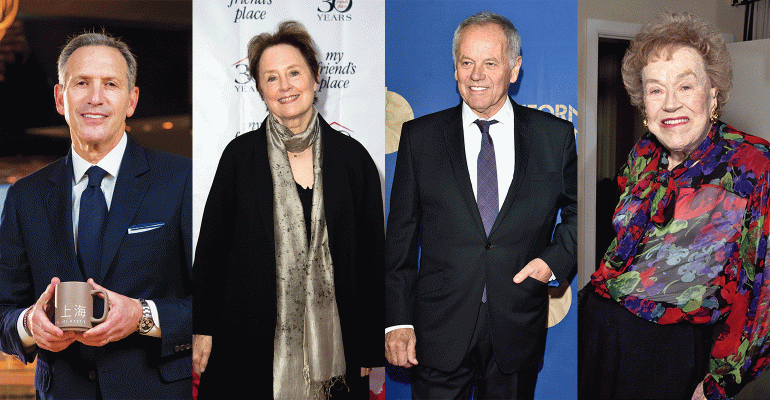Jim Sullivan is a popular keynote speaker at leadership, franchisee and GM conferences worldwide. This article does not necessarily reflect the opinions of the editors or management of Nation’s Restaurant News.
How can an industry as big and influential as foodservice not have a dedicated and permanent home in which to honor its achievers, achievements, and innovators that impacted American culture and business?
It’s time to lay the groundwork for creating a Foodservice Hall of Fame.
I just finished a highly entertaining read called The Book of Basketball by Bill Simmons. Near the end he lays out a persuasive case for re-designing the Basketball Hall of Fame in Springfield, Mass. He suggests a new five-floor pyramid layout that features a rotating cast of recent and classic all-stars on each floor which becomes smaller as one ascends, with the lower floors housing the first level of deserving exceptional players, and each succeeding floor honoring more — but fewer — exceptional players.
The top floor would house “The Pantheon,” or the top five best players of all time. Players would be voted up or down annually into each deserving floor. Simmons suggests this layout would accommodate the exceptionally talented new players that arise with each succeeding generation while still honoring the past All-Stars. It’s a brilliant idea.
So I began thinking about a Foodservice Hall of Fame, who the inductees might be, and how to place them in a similar design scheme. But I immediately hit a huge roadblock: there is no Foodservice Hall of Fame in which to place them. In a world that can accommodate a full-time Mustard Museum (Middleton, Wis.) and a Spam Museum (Austin, Minn.), how and why is there no Foodservice Hall of Fame?
The first order of business is to create such a museum. The second more challenging — and fun — item is determining who the inaugural inductees would be.
Applying Bill Simmons’ methodology to the facility’s design would be a must, because time changes perception and contributions evolve across generations and tastes. For instance, ask the average American in 1970 to list foodservice All-Stars and you’d probably hear names like Julia Child, Howard Johnson, Colonel Sanders and Graham Kerr. In 1985 they might say Paul Prudhomme, Ray Kroc, James Beard, Norman Brinker, Wolfgang Puck, and Dave Thomas. In 1995 the list would include names like Emeril Lagasse, Rich Melman, Charlie Trotter, and Martin Yan. Fast-forward twenty-five years to today and the list would be significantly more expansive, reflecting both how often Americans dine out today and the proliferation of TV shows and channels dedicated 24/7 to food and dining.
The first floor, the foundation of the Foodservice Hall of Fame, would honor the two groups most responsible for enabling innovation and supporting our industry’s growth: foodservice employees and restaurant customers. There would also be a wing for innovators who were neither chef nor concept creator but still significantly contributed to the development and growth of the foodservice industry, including areas like manufacturing, sanitation, franchising, education, beverages and distribution.
Our 2020 Pantheon, or top floor, would honor the following seven innovators: Fred Harvey, James Beard, Ray Kroc, Julia Child, “Billy” Ingram, Howard Johnson, and Harland Sanders. A permanent place on the top floor would honor the “Greensboro Four” (Ezell Blair Jr., David Richmond, Franklin McCain and Joseph McNeil), the brave African-American college students who staged the Woolworth’s lunch counter sit-in sixty years ago on February 1, 1960, a watershed moment in both the foodservice industry and the history of Civil Rights and our nation.
Each lower would include honorees whose relative merits and contributions would be ranked, rated and re-assessed annually. The Hall would surely include — but not be limited to — notables like Norman Brinker, Alice Waters, Victor H. Green, Warner LeRoy, William Rosenberg, Fred DeLuca, Dick McDonald, Mac McDonald, John V. Brown, Wolfgang Puck, Alessandro Fillippini, Paul Prudhomme, Alan Stillman, José Andrés, Susan Feniger, Roy Allen, Charles Ranhofer, Frank and Don Thomas, Jim Collins, Eugénie Brazier, Glen Bell, Frank Wright, Danny Meyer, Duncan Hines, Mike Hurst, David Overton, John Martin, Rick Bayless, Ella Brennan, Ming Tsai, Louis Szathmay, Rick Bayless, Nobuyuki Matsuhisa, Jerry Berns, Howard Schultz, Jacques Pepin, and Jonathan Waxman, among many others. (If you’re unfamiliar with any of these names, look them up now).
Every year the Foodservice Hall of Fame voters will re-assess, re-elect and re-select its member’s floor designations upward or downward based on exceptional new talent, earned innovation or fresh insight, since time and revelation re-aligns thinking. Who would you nominate for induction into the Foodservice Hall of Fame?
And who’s with me? It’s time to make this idea a reality.
Jim Sullivan is a popular keynote speaker, author and consultant in the restaurant industry. Companies using his products or programs include Starbucks, Panera, Chipotle, McDonald’s and Texas Roadhouse. His two books Fundamentals and Multiunit Leadership have sold over 330,000 copies worldwide and he has over 400,000 social media followers at LinkedIn, Twitter and YouTube. He’s a foodservice history buff and lives in Wisconsin.





